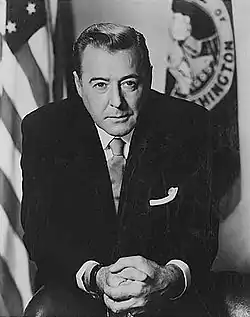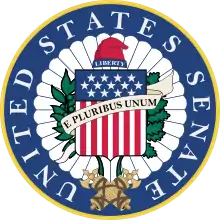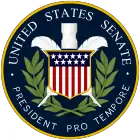Warren Magnuson
Warren Grant "Maggie" Magnuson (April 12, 1905 – May 20, 1989) was an American lawyer and politician who served as a United States Senator from Washington from 1944 to 1981. A member of the Democratic Party, he previously served as a U.S. Representative from 1937 to 1944. He was the state's longest-serving senator, serving over 36 years in the Senate. During his final two years in office, he was the most senior senator and President Pro Tempore.
Warren Magnuson | |
|---|---|
 | |
| President pro tempore of the United States Senate | |
| In office December 6, 1980 – January 3, 1981 | |
| Preceded by | Milton Young |
| Succeeded by | Strom Thurmond |
| In office January 3, 1979 – December 5, 1980 | |
| Preceded by | James Eastland |
| Succeeded by | Milton Young |
| Chair of the Senate Appropriations Committee | |
| In office January 3, 1977 – January 3, 1981 | |
| Preceded by | John Little McClellan |
| Succeeded by | Mark Hatfield |
| Chair of the Senate Commerce Committee | |
| In office January 3, 1955 – January 3, 1977 | |
| Preceded by | John W. Bricker |
| Succeeded by | Howard Cannon |
| United States Senator from Washington | |
| In office December 14, 1944 – January 3, 1981 | |
| Appointed by | Arthur B. Langlie |
| Preceded by | Homer Bone |
| Succeeded by | Slade Gorton |
| Member of the U.S. House of Representatives from Washington's 1st district | |
| In office January 3, 1937 – December 13, 1944 | |
| Preceded by | Marion Zioncheck |
| Succeeded by | Emerson DeLacy |
| Member of the Washington House of Representatives from the 37th district | |
| In office January 9, 1933 – January 14, 1935 | |
| Preceded by | George F. Murray |
| Succeeded by | A. Lou Cohen |
| King County Prosecuting Attorney | |
| In office January 1, 1935 – January 3, 1937 | |
| Personal details | |
| Born | Warren Grant Magnuson April 12, 1905 Moorhead, Minnesota, U.S. |
| Died | May 20, 1989 (aged 84) Seattle, Washington, U.S. |
| Resting place | Acacia Memorial Park 47.73920°N 122.29280°W |
| Political party | Democratic |
| Spouse(s) | Eleanor Peggy "Peggins" Maddieux
(m. 1928; div. 1935) |
| Education | University of North Dakota North Dakota Agricultural College University of Washington (BA, LLB) |
| Profession | Attorney |
| Military service | |
| Allegiance | |
| Branch/service | |
| Battles/wars | World War II |
Early life and education
Warren Magnuson was born in Moorhead, Minnesota.[3] His birthdate is supposedly April 12, 1905, but the actual records of his birth are sealed.[4] According to various sources, he never knew his birth parents; they may have died within a month of his birth,[5] or his unmarried mother put him up for adoption.[6] William Grant and Emma (née Anderson) Magnuson adopted Warren, who gave him their name.[7] The Magnusons were second-generation Scandinavian immigrants who operated a bar in Moorhead, and adopted a daughter, Clara, a year after adopting Warren.[8] His adoptive father left the family in 1921.[4]
Magnuson attended Moorhead High School, where he played quarterback on the football team and was captain of the baseball team.[6] While in high school, he ran a YMCA camp, worked on wheat farms, and delivered newspapers and telegrams in Moorhead and nearby Fargo, North Dakota.[7] He graduated in 1923, and then enrolled at the University of North Dakota in Grand Forks.[3] In 1924, he transferred to the North Dakota Agricultural College in Fargo, which he attended for a year.[6] He then traveled through Canada for some time, riding freight trains and working with threshing crews.[7]
Magnuson followed a high school girlfriend to Seattle, Washington, where he entered the University of Washington in 1925.[8] He was a member of Theta Chi fraternity, and worked delivering ice as a Teamsters member under Dave Beck.[4] He received a Bachelor of Arts degree in 1926, and earned a Bachelor of Laws degree from the University of Washington School of Law in 1929.[3] A Democrat, he first became active in politics in 1928, volunteering for A. Scott Bullitt for governor and Al Smith for president.[6]
Early career
In 1929, Magnuson was admitted to the bar and joined the law office of Judge Samuel Stern in Seattle.[6] He served as secretary of the Seattle Municipal League from 1930 to 1931[3] and served as a special prosecutor for King County in 1932, investigating official misconduct.[5] He founded the state chapter of the Young Democrats of America that same year.[9] He was a leading supporter of repealing state Prohibition laws and establishing the state Liquor Control Board.[10]
From 1933 to 1935, Magnuson served as a member of the Washington House of Representatives from the Seattle-based 37th Legislative District.[10] As a state legislator, he sponsored the first unemployment compensation bill in the nation.[7] Magnuson was a delegate to the state constitutional convention in 1933.[3] He briefly served as Assistant United States District Attorney before being elected prosecuting attorney of King County, serving from 1934 to 1936.[7]
Congressional career
Magnuson was first elected to the House of Representatives in 1936, filling a vacancy caused by the sudden death of fellow Democrat Marion Zioncheck on August 7, 1936. In 1937, along with senators Homer Bone and Matthew Neely, Magnuson introduced the National Cancer Institute Act, signed into law by Franklin Roosevelt on August 5 of that year.[11] He was reelected in 1938, 1940, and 1942. After the Attack on Pearl Harbor, Magnuson was a staunch supporter of the U.S. war effort.[12]
Magnuson served in the United States Navy during World War II. He was aboard the aircraft carrier USS Enterprise for several months, seeing heavy combat in the Pacific Theatre until Roosevelt ordered all congressmen on active duty to return home in 1942.
In 1944, Magnuson successfully ran for the U.S. Senate. On December 14, 1944, Governor Arthur B. Langlie appointed Magnuson to fill the vacancy created by Homer Bone's appointment to the Ninth Circuit Court of Appeals, thus resigning from the House and starting his Senate tenure a month early.
Magnuson was reelected in 1950, 1956, 1962, 1968, and 1974. He served on the Senate Commerce Committee throughout his tenure in the Senate, and the Senate Appropriations Committee during his final term. Magnuson served most of his tenure in the Senate alongside his friend and Democratic colleague from Washington State, Henry M. "Scoop" Jackson. State Attorney General Slade Gorton defeated Magnuson in the 1980 election.
In August 1950, Magnuson proposed voluntary enlistment for the Japanese in the American armed forces and sent a cable request to General Douglas MacArthur on the practicality of the proposal.[13]
In November 1961, President John F. Kennedy visited Seattle and was an honored guest at a celebration honoring Magnuson's first 25 years in Congress.[14][15] Nearly 3,000 people paid $100 each to attend the dinner.
At the end of August 1966, after President Lyndon Johnson announced the nominations of Charles F. Luce for Undersecretary of the Interior, John A. Carver for Federal Power Commission membership, and David S. Black for BPA administrator, Magnuson announced the Senate Commerce committee would hold hearings on Carver's nomination on September 1. He called Luce "one of the most able, dedicated, productive public servants I know."[16]
On November 7, 1967, Johnson signed the Public Broadcasting Act of 1967, citing Magnuson as one of the members of Congress to "have been part of the team that has brought this measure to the White House to make it the law of our land."[17]
At least three important pieces of legislation bear his name: the Magnuson-Stevens Fishery Conservation and Management Act, the Chinese Exclusion Repeal Act of 1943 (commonly referred to as the Magnuson Act), and the Magnuson-Moss Warranty Act. He was also instrumental in keeping supertankers out of Puget Sound, by slipping through an amendment to a routine funding reauthorization bill on the Senate and House consent calendars.[18]
The bill that became the Civil Rights Act of 1964 was referred to the Committee on Commerce. Magnuson played a key role in getting it to the floor and enacted into law despite vigorous opposition by Senator William Fulbright and other staunch segregationists.
Magnuson was responsible for special legislation that allowed Poon Lim, a Chinese sailor who in 1942 survived 133 days alone at sea as a castaway, to immigrate to the U.S.
Magnuson attended the May 5, 1978, dedication ceremony for Riverfront Park in Spokane.[19] Shortly after that, during a town hall meeting, President Jimmy Carter said, "No one could be in a better political position than to be preceded and introduced by men like Tom Foley and Senator Warren Magnuson. I know of no one in the Congress than these two men who are more respected, more dedicated to serving their own people well, but who have also reached, because of their experience and knowledge, sound judgment and commitment, a position of national and even international renown and leadership."[20]
Personal life
In 1928, Magnuson married Eleanor Peggy "Peggins" Maddieux, crowned Miss Seattle the previous year.[6] They remained together until their divorce in 1935.[10] Magnuson dated several glamorous women, including heiress and cover girl June Millarde and actress Carole Parker.[4] In 1964, he married Jermaine Elliott Peralta (1923–2011), widowed as a teenager, in a ceremony conducted by Rev. Frederick Brown Harris at the Omni Shoreham Hotel.[10] The couple remained together until his death, and he helped raise Peralta's daughter from her previous marriage, Juanita.[5] Magnuson and his wife are interred in Acacia Memorial Park in Lake Forest Park, north of Seattle.[21]
Namesakes
- Warren G. Magnuson Health Sciences Building at the University of Washington's Health Sciences building complex was named in his honor in 1970.
- Warren Magnuson's Senate desk is located in an alcove in the Suzzallo Library graduate reading room at the University of Washington.
- Warren G. Magnuson Clinical Center at the National Institutes of Health in Bethesda, Maryland is also named for Senator Warren Magnuson.
- Warren G. Magnuson Park in northeast Seattle was named in his honor in 1977.
- Warren G. Magnuson Puget Sound Legacy Award has been established by the People For Puget Sound
- The Washington State Democratic Party[22] holds an annual Magnuson awards dinner (sometimes referred to as the Maggies, per his nickname).
- The Intercollegiate College of Nursing building in Spokane on Fort George Wright Drive near Spokane Falls Community College is named after him.
References
- "Magnuson weds Seattle widow". Spokane Daily Chronicle. United Press International. October 5, 1964. p. 2.
- "Jermaine Elliott Magnuson". Find a Grave. Retrieved December 17, 2012.
- "MAGNUSON, Warren Grant, (1905 - 1989)". Biographical Directory of the United States Congress.
- Oldham, Kit (October 14, 2003). "Magnuson, Warren G. (1905-1989)". HistoryLink.
- Saxon, Wolfgang (May 21, 1989). "Warren G. Magnuson Dies at 84; Held Powerful Positions in Senate". The New York Times.
- Scates, Shelby (1997). Warren G. Magnuson and the Shaping of Twentieth-Century America. University of Washington Press.
- Current Biography. Vol. II. H. W. Wilson Company. 1945.
- Van Dyk, Ted (April 13, 2005). "Warren Magnuson was one of a kind". Seattle Post-Intelligencer.
- "About the Young Democrats of Washington State".
- "Warren "Maggie" Magnuson". Secretary of State of Washington.
- Mukherjee, Siddhartha (November 16, 2010). The Emperor of All Maladies: A Biography of Cancer. Simon and Schuster. p. 25. ISBN 978-1-4391-0795-9. Retrieved September 6, 2011.
- Magnuson was instrumental in securing a commission in the U.S. Army for Bob Struble in 1942.
- Arming of Germans, Japanese Proposed to Meet Red Threat (August 5, 1950)
- "President Kennedy delivers major policy speech at UW on November 16, 1961. - HistoryLink.org". www.historylink.org. Retrieved December 16, 2017.
- "JackGordon.org: Kennedy is Guest of Honor at Dinner honoring Sen. Warren Magnuson during his November, 1961, visit to Seattle". Retrieved December 16, 2017.
- "LBJ nominates Charles F. Luce to Interior Post". The Bulletin. September 1, 1966.
- Johnson, Lyndon B. (November 7, 1967). "474 - Remarks Upon Signing the Public Broadcasting Act of 1967". American Presidency Project.
- HistoryLink.org, the online encyclopedia of Washington State history. Accessed July 19, 2006
- Carter, Jimmy (May 5, 1978). "Spokane, Washington Remarks at Dedication Ceremonies for Riverfront Park". American Presidency Project.
- Carter, Jimmy (May 5, 1978). "Spokane, Washington Remarks and a Question-and-Answer Session at a Town Meeting". American Presidency Project.
- "Warren Grant Magnuson". Find a Grave. Retrieved December 17, 2012.
- "Washington State Democratic Party". Washington State Democratic Party. Retrieved December 16, 2017.
Related reading
- Scates, Shelby Warren G. Magnuson and the Shaping of Twentieth-Century America (Seattle: University of Washington Press, 1997)
External links
- United States Congress. "Warren Magnuson (id: M000053)". Biographical Directory of the United States Congress.
- Washington State History Link Entry
- History Link.org - Warren Magnuson
- Find a Grave.com - Warren Grant Magnuson
- NIH Clinical Center — The research hospital was renamed the Warren Grant Magnuson Clinical Center in his honor on October 22, 1981.
- Warren G. Magnuson Puget Sound Legacy Awards
- A film clip "Longines Chronoscope with Warren G. Mangnuson (SIC)" is available at the Internet Archive

